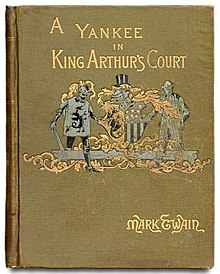
A time slip is a plot device in fantasy and science fiction in which a person, or group of people, seem to accidentally travel through time by unknown means, or by a means unknown to the character(s). [1] [2] [3]
The idea of a time slip was used in 19th century fantasy, an early example being Washington Irving's 1819 Rip Van Winkle, where the mechanism of time travel is an extraordinarily long sleep. [4] Time-slip stories were popularized at the end of the century by Mark Twain's 1889 historical novel A Connecticut Yankee in King Arthur's Court, which had considerable influence on later writers. [5]
Time slip is one of the main plot devices of time travel stories, another being a time machine. The difference is that in time slip stories, the protagonist typically has no control and no understanding of the process (which is often never explained at all) and is either left marooned in a past or future time and must make the best of it, or is eventually returned by a process as unpredictable and uncontrolled as the journey out. [6]
Paleontologist George Gaylord Simpson wrote a novella, published posthumously, The Dechronization of Sam Magruder, about a scientist who experiences a time slip from 2162 back into the Cretaceous Period. In this case, the time slip is accidental, but the protagonist understands the mechanism, which came about due to his experiments into the quantum nature of time.
The plot device is also popular in children's literature. [7] [8]
See also
References
- ^ Historical Dictionary of Science Fiction Literature, "Timeslip romance", p. 357
- ^ Anders, Charlie Jane (12 June 2009). "Timeslip romance". io9. Retrieved 27 August 2015.
- ^ Palmer, Christopher (2007). Philip K. Dick: Exhilaration and Terror of the Postmodern (Reprint ed.). Liverpool: Liverpool University Press. p. 146. ISBN 978-0-853236184. Retrieved 11 February 2017.
- ^ Lee, Maggie (12 April 2016). "Film Review: 'A Bride for Rip Van Winkle'". Variety. Retrieved 30 April 2021.
- ^ James, Edward; Mendlesohn, Farah (2002). The Cambridge Companion to Fantasy Literature. Cambridge: Cambridge University Press. p. 106. ISBN 9781107493735. Retrieved 11 February 2017.
- ^ Schweitzer, Darrell (2009). The Fantastic Horizon: Essays and Reviews (1st ed.). Rockville, Maryland: Borgo Press. p. 112. ISBN 9781434403209. Retrieved 22 September 2017.
- ^ Lucas, Ann Lawson (2003). The Presence of the Past in Children's Literature. Westport, Connecticut: Praeger. p. 113. ISBN 978-0-313324833.
- ^ Cosslett, Tess (1 April 2002). ""History from Below": Time-Slip Narratives and National Identity". The Lion and the Unicorn. 26 (2): 243–253. doi: 10.1353/uni.2002.0017. ISSN 1080-6563. S2CID 145407419. Retrieved 22 September 2017.
External links
- "Timeslip". The Encyclopedia of Science Fiction.

A time slip is a plot device in fantasy and science fiction in which a person, or group of people, seem to accidentally travel through time by unknown means, or by a means unknown to the character(s). [1] [2] [3]
The idea of a time slip was used in 19th century fantasy, an early example being Washington Irving's 1819 Rip Van Winkle, where the mechanism of time travel is an extraordinarily long sleep. [4] Time-slip stories were popularized at the end of the century by Mark Twain's 1889 historical novel A Connecticut Yankee in King Arthur's Court, which had considerable influence on later writers. [5]
Time slip is one of the main plot devices of time travel stories, another being a time machine. The difference is that in time slip stories, the protagonist typically has no control and no understanding of the process (which is often never explained at all) and is either left marooned in a past or future time and must make the best of it, or is eventually returned by a process as unpredictable and uncontrolled as the journey out. [6]
Paleontologist George Gaylord Simpson wrote a novella, published posthumously, The Dechronization of Sam Magruder, about a scientist who experiences a time slip from 2162 back into the Cretaceous Period. In this case, the time slip is accidental, but the protagonist understands the mechanism, which came about due to his experiments into the quantum nature of time.
The plot device is also popular in children's literature. [7] [8]
See also
References
- ^ Historical Dictionary of Science Fiction Literature, "Timeslip romance", p. 357
- ^ Anders, Charlie Jane (12 June 2009). "Timeslip romance". io9. Retrieved 27 August 2015.
- ^ Palmer, Christopher (2007). Philip K. Dick: Exhilaration and Terror of the Postmodern (Reprint ed.). Liverpool: Liverpool University Press. p. 146. ISBN 978-0-853236184. Retrieved 11 February 2017.
- ^ Lee, Maggie (12 April 2016). "Film Review: 'A Bride for Rip Van Winkle'". Variety. Retrieved 30 April 2021.
- ^ James, Edward; Mendlesohn, Farah (2002). The Cambridge Companion to Fantasy Literature. Cambridge: Cambridge University Press. p. 106. ISBN 9781107493735. Retrieved 11 February 2017.
- ^ Schweitzer, Darrell (2009). The Fantastic Horizon: Essays and Reviews (1st ed.). Rockville, Maryland: Borgo Press. p. 112. ISBN 9781434403209. Retrieved 22 September 2017.
- ^ Lucas, Ann Lawson (2003). The Presence of the Past in Children's Literature. Westport, Connecticut: Praeger. p. 113. ISBN 978-0-313324833.
- ^ Cosslett, Tess (1 April 2002). ""History from Below": Time-Slip Narratives and National Identity". The Lion and the Unicorn. 26 (2): 243–253. doi: 10.1353/uni.2002.0017. ISSN 1080-6563. S2CID 145407419. Retrieved 22 September 2017.
External links
- "Timeslip". The Encyclopedia of Science Fiction.